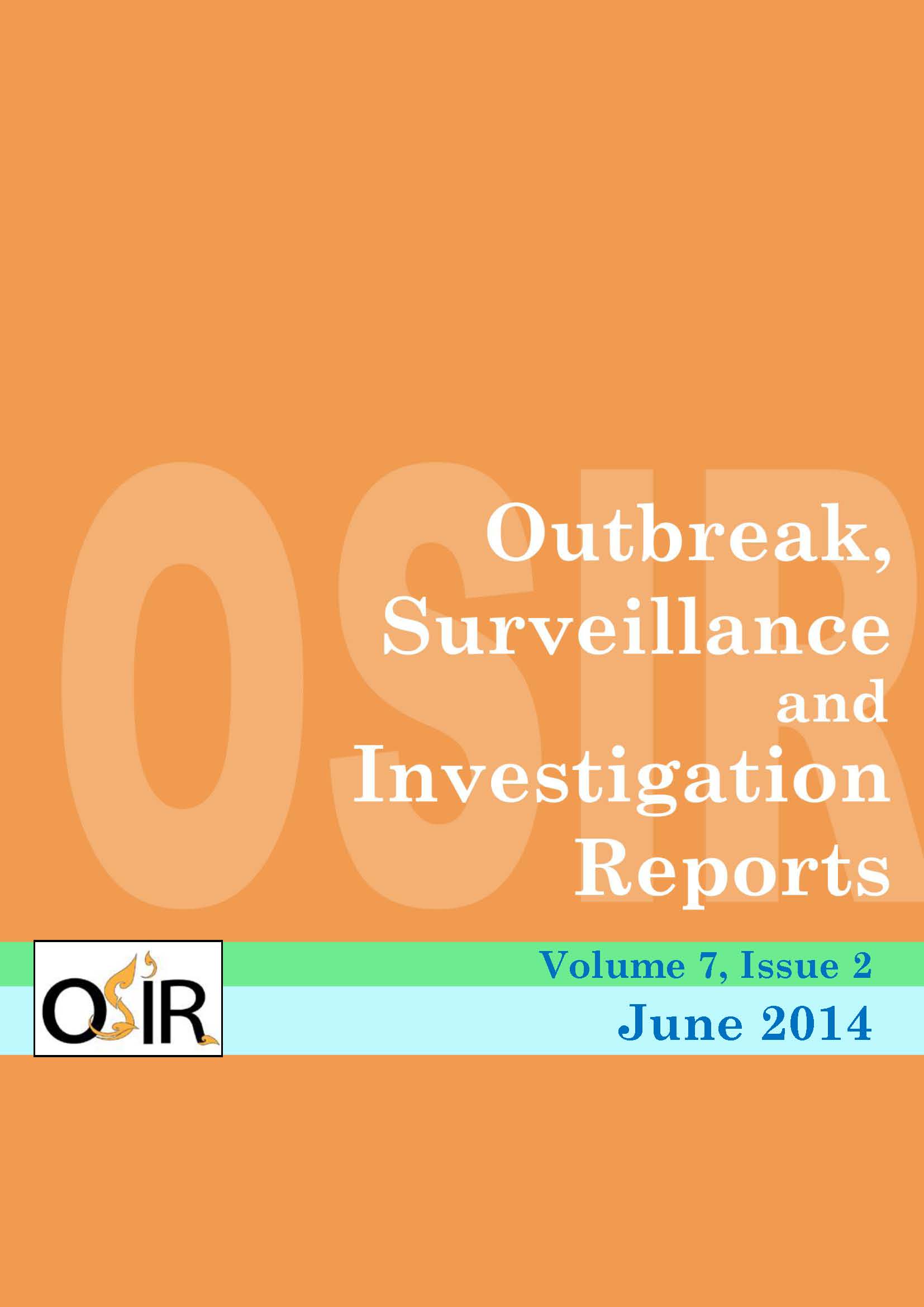Influenza Viruses in Children Attending Yangon Children Hospital, Myanmar during Influenza Season in 2013
DOI:
https://doi.org/10.59096/osir.v7i2.263290Keywords:
influenza, children, respiratory diseases, MyanmarAbstract
Globally, circulating subtypes of human and avian H5 influenza viruses occasionally cause epidemics. To determine the burden of influenza virus among children with influenza-like illness (ILI) who visited a hospital in Yangon, a cross-sectional study was conducted in Yangon Children Hospital from June to August 2013. Nasal swabs were taken from 100 children with ILI and viral RNA was tested by reverse transcription polymerase chain reaction (RT-PCR). Samples positive of influenza A virus were subtyped by multiplex RT-PCR. Of 100 ILI cases, six cases (6%) revealed matrix gene of influenza A virus. Five (83.3%) out of six influenza A cases were of seasonal H3 subtype and one case (16.7%) was of pandemic H1 subtype. In 2013, majority of influenza A viruses found in ILI children was seasonal H3 subtype that was different from the previous findings during 2010-2011 when pandemic H1 subtype was predominant. The results highlighted that subtyping of influenza viruses should be continued to determine trends of predominant influenza subtype and hence, to estimate the disease outbreaks.
References
Regional Office for Europe. World Health Organization. Guideline for influenza surveillance in humans, 2009 [cited 2013 Apr 10]. <http://www.euro.who.int/en/health-topics/communicable-diseases/influenza/publications/2009/who-regional-office-for-europe-guidance-for-sentinel-influenza-surveillance-in-humans.html>
Hasegawa G, Kyaw Y, New HM, Li DJ, Saito R, Suzuki H, et al. Epidemiological study of influenza virus infections in Yangon, Myanmar. Tropical Medicine and Health. 2006; 34(1):3-6.
Dapat C, Saito R, Kyaw Y, Naito M, Hasegawa G, Suzuki Y, et al. Epidemiology of human influenza A and B viruses in Myanmar from 2005 to 2007. Intervirology. 2009;52(6):310-20. Epub 2009 Sep 17.
Bouvier NM, Palese P. The biology of influenza viruses. Vaccine. 2008 Sep 12;26 Suppl 4:D49-53.
Flu Gov. Pandemic flu history [cited 2013 June 15]. <http://www.flu.gov/pandemic/history.html>
Tam JS. Influenza A (H5N1) in Hong Kong: an overview. Vaccine. 2002 May 15;20 Suppl 2:S77-81.
Dudley JP. Age-specific infection and death rates for human A(H5N1) avian influenza in Egypt. Euro Surveill. 2009 May 7;14(18). pii: 19198.
Centers for Disease Control and Prevention. Overview of influenza surveillance in the United States. 2013 [cited 2013 Apr 10]. <http://www.cdc.gov/flu/weekly/overview.htm>
World Health Organization. Collecting, preserving and shipping specimens for the diagnosis of avian influenza A(H5N1) virus infection: guide for field operations. 2006 Oct. p. 42-3.
Fouchier RA1, Bestebroer TM, Herfst S, Van Der Kemp L, Rimmelzwaan GF, Osterhaus AD. Detection of influenza A viruses from different species by PCR amplification of conserved sequences in the matrix gene. J Clin Microbiol. 2000 Nov;38(11):4096-101.
Poomipak W, Pongsiri P, Makkoch J, Poovorawan Y, Payungporn S. Molecular detection and subtyping of human influenza A viruses based on multiplex RT-PCR assay. International Research Journal of Biotechnology. 2011 Apr; 2(4): 85-92.
Cox NJ, Subbarao K. Global epidemiology of influenza: past and present. Annu Rev Med. 2000;51:407-21.
Puzelli S, Valdarchi C, Ciotti M, Dorrucci M, Farchi F, Babakir-Mina M, et al. Viral causes of influenza-like illness: insight from a study during the winters 2004-2007. J Med Virol. 2009 Dec;81(12):2066-71.
Garcia J, Espejo V, Nelson M, Sovero M, Villaran MV, Gomez J, et al. Human rhinoviruses and enteroviruses in influenza-like illness in Latin America. Virol J. 2013 Oct 11;10:305.
Balinandi S, Bakamutumaho B, Kayiwa JT, Ongus J, Oundo J, Awor AC, et al. The viral aetiology of influenza-like illnesses in Kampala and Entebbe, Uganda, 2008. African Journal of Laboratory Medicine. 2013;2(1):1-5.
Centre for Disease Control and Prevention. Notice to readers: considerations for distinguishing influenza-like illness from inhalational anthrax. Morbidity and Mortality Weekly Report. 2001 Nov 9;50(44):984-6.
Lin H, Thu HM, Khin KK, Wai KT, Oo WM, Aye KM, et al. Detection of influenza and parainfluenza viruses in children with acute respiratory infection attending Yangon Children Hospital. The Myanmar Health Sciences Research Journal. 2011;23(1):26-31.
Alberta Health Services. Laboratory bulletin. 2013 February 28 [cited 2013 Sep 10]. <http://www.albertahealthservices.ca/LabServices/wf-lab-bulletin-pl-summary-respiratory-influenza-virus-final.pdf>
Myanmar. Department of Medical Research (Lower Myanmar). Ministry of Health. Annual report. 2012. p. 100.
Downloads
Published
How to Cite
Issue
Section
License
Copyright (c) 2023 Outbreak, Surveillance, Investigation & Response (OSIR) Journal

This work is licensed under a Creative Commons Attribution-NonCommercial-NoDerivatives 4.0 International License.









